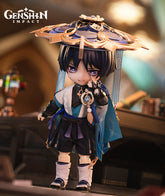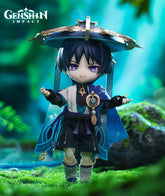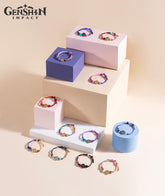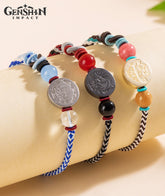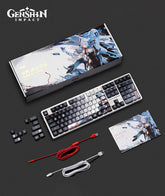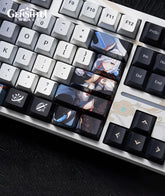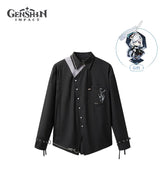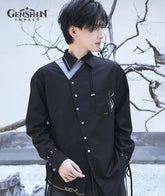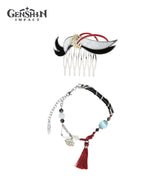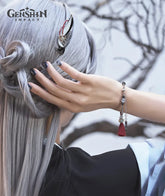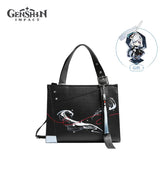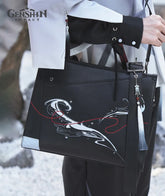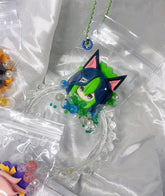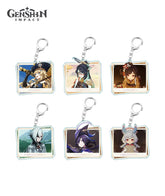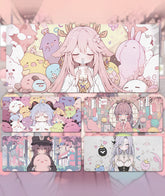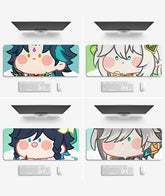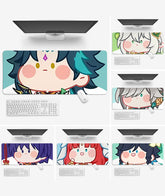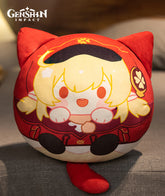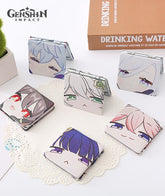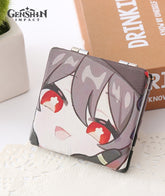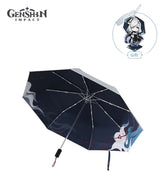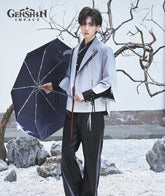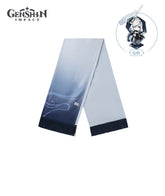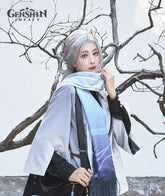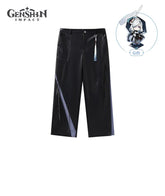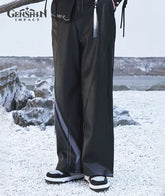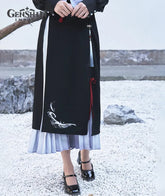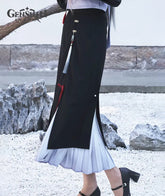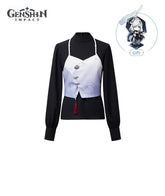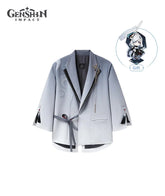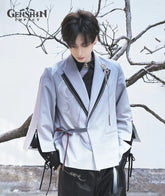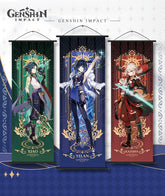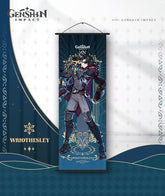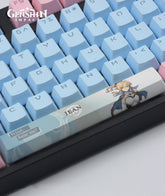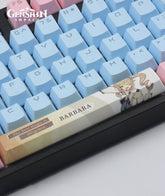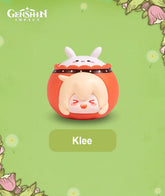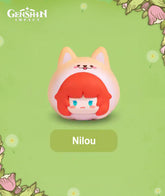Genshin Shenhe Costume Design: Frost-Plumed Elegy, Mortal Dust Dissolving
Welcome back to the Genshin Impact Channel! Today, let's dive deep into Shenhe-the adeptal disciple trained by Cloud Retainer-and uncover the cultural inspirations and authentic references hidden within her costume design!
Shenhe is a favorite for so many travelers, and I'm betting most Travelers are super curious about what exactly inspired her look. So, buckle up and join me as we dig into all the fascinating details!
1. Genshin Impact Shenhe—Namecard "Comb"
Shenhe's namecard is called "Comb," with the Chinese name being 栉掠, meaning to groom one's hair. In the phrase "combing one's hair (以梳栉发)," the character "梳" functions as a noun meaning "comb," while "栉" acts as a verb meaning "to comb."

According to the exegetical book Shiming·Shi Shoushi from China's Eastern Han Dynasty, "A comb (梳) is named for the sparseness of its teeth." Combs worn on the head for adornment were also called zhi (栉). Such hair ornaments emerged no later than the Eastern Jin Dynasty, and by the Tang Dynasty in China, they became wildly popular among women. The poet Wang Jian's Palace Poems vividly depicted the elegant hairstyles of Tang women and the intricate complexity of hairpins and combs in their coiffures. The Tang painter Zhang Xuan's Court Ladies Preparing Newly Woven Silk portrayed noblewomen adorned with hair combs.

Beyond aesthetics and practicality, hair combs (梳栉) served as tokens of affection. In ancient China, when men and women exchanged combs, it symbolized a vow to stay together for life, growing old side by side with white hair. In miHoYo's other game, Tears of Themis, the male character Lu Jinghe gifts the female protagonist (that is, the player) a jade comb in the Anniversary Limited Thought to express love.
The renowned Southern Dynasties folk poem Ballad of the Western Isles records, "Beneath the tree before the gate, behind the gate glimmers a cuidian (翠钿)." (The more widely known closing lines are "May the south wind know my heart, carrying my dreams to the Western Isles.") During the Tang Dynasty, "cuidian" referred to hair ornaments worn by women. A cuidian was crafted by adhering kingfisher feathers onto a gold base. Thus, the Jade Comb Adorned with Kingfisher Feathers (翠钿白玉梳) was a white jade comb decorated with these iridescent green feathers. The "Three-Comb Ritual" (梳之礼) originated from wedding customs where a bride's hair was combed: with the first comb, blessings for a smooth marriage; with the second, hopes for growing old together; with the third, wishes for abundant descendants.

2. Shenhe Costume Design—Hair Ornament
Shenhe's hair comb is styled after the Glaze Lily. Wild Glaze Lilies grow in the mountains, and Shenhe herself is like a solitary blossom in these secluded heights, standing alone in her grace

3. Shenhe Costume Design—Red Ropes
Ancient Chinese people believed that the color red symbolized auspiciousness and safety, possessing the power to ward off evil and disasters. Red ropes could bless the wearer with protection, bringing good fortune and wisdom; they calmed the wearer's mind and purified distracting thoughts.

The arrangement of red ropes on Shenhe's attire may originate from the traditional Chinese "juàn" (絭). Since Shenhe's garment features streamlined narrow sleeves, these ropes do not function to push up and secure the sleeves but serve as ornaments, resembling an imitation of the "juàn" form.
In ancient Chinese texts, "juàn" refers to an "arm-binding rope" used to roll up sleeves and expose the elbows. As recorded in the Yuefu Poetry Anthology·Qingshang Melodies·West Crow Night Flight:
"Felt thy rugged devotion, cast my worries away.
Twin ropes knot as one on arms; bound as one, we go."
(Meaning: I am moved by your unwavering affection, henceforth free from solitary concerns; the ropes tied on both arms form a united knot, symbolizing our inseparable bond.)
4. Shenhe Costume Design—Swastika Knot
Shenhe's earrings and garment ornaments all derive from the traditional Chinese knot-the swastika knot. The swastika knot is regarded as symbolizing auspiciousness and boundless fortune; its four ends extend vertically and horizontally, interlocking into various patterns, signifying eternal and unbroken continuity.

5. Shenhe Costume Design—"Flowing Clouds" and "Auspicious Clouds" Patterns
The ink-colored swirling lines unfurl gently like flowing clouds, full of dynamism, carrying an immortal aura. The golden patterns resemble auspicious ruyi clouds, graceful and full in form, symbolizing clouds of good fortune. Auspicious clouds are, by legend, the colorful clouds that immortals ride upon, and in ancient paintings, they are often depicted accompanying cranes. These motifs further express wishes for prosperity, joy, and happiness, as well as a beautiful yearning for life.

The official Genshin Impact Shenhe Clothing cleverly incorporates flowing‑cloud and auspicious‑cloud motifs throughout, enhancing its ethereal, elegant style.
6. Genshin Impact Shenhe Costume Design—Crane
Shenhe's design may to some extent reference the Demoiselle Crane; the Demoiselle Crane is serene and elegant, with a petite body frame.

Shenhe's attire as a whole resembles a freehand ink-wash painting. The subtle blending and intentional blank spaces create a contrast yet harmony between black and white. The area below the abdomen is predominantly black, while the upper body features lighter tones. This gradient elongates her leg lines, closely mirroring the crane's slender limbs. Only the chest area, sleeves, and hem of the outer robe are white, visually evoking the fluffy, expansive texture of crane feathers. The silhouette further echoes the wings and tail plumage of a crane.
As recorded in the Ancient Guqin Lore:
"Long ago, two white cranes on Mount Heng transformed into divine maidens. They danced upon a platform, then plucked the 'Luo Xia' guqin and sang the 'Pure Wu Spring Waves' melody, resonating across the mountains."
Thus, Shenhe's connection to the "Divine Damsel" image finds roots in classical lore.
In ancient China, the text Xiang He Jue (Treatise on Crane Physiognomy) stated that cranes do not consume earthly sustenance. In the Archon Quest "The Crane Returns on the Wind," Shenhe is seen eating Qingxin flowers, Glaze Lilies, and Violetgrass, showing no attachment to human delicacies.
The He Jing (Crane Classic) declares, "The crane, a yang bird, roams amidst yin. Sustained by metal's essence and fire's spirit." As "a yang bird that traverses yin," during the PV "Crane in the Wild," Shenhe's ice puppet displays the three yang trigrams-Gen (艮), Kan (坎), and Li (离)-on her arms, abdomen, and legs. In her exorcisms, transitions feature crane cries and soaring imagery. This alignment likely reflects Shenhe's innate affinity for the arcane and her aptitude for cultivation.

The Book of Songs states, "The crane cries at the marsh's edge, its voice heard in heaven." Cranes dwell in mountain wilds, aloof from worldly strife, yet when they cry toward the sky, their voice echoes across the land. So too is Shenhe: though she lives in seclusion, unknown to the world, she remains kind-hearted, saving others in peril. She also holds a desire to engage with the mortal world-when Liyue faced invasion by the God Beisht, she stepped forward to protect Liyue's people, the Millelith, and the Traveler.
Unlike Ganyu, who bears half-human blood and endures loneliness among both humans and adepti, Shenhe is human and must ultimately return to the mortal realm. The final lines of the PV "The Divine Damsel of Devastation" carry profound double meaning:
"The crane once returned. And once she was spurned, she turned and left alone.
Now, she might be found with friends all around to whom she is bound-a home."

This thorough examination of Shenhe's attire concludes here. Beyond Shenhe's costume, both her and other Genshin Impact character designs are profoundly worthy of in-depth study! Travelers intrigued by this topic can look forward to the next installment of character analysis articles, where we will continue to deliver high-quality content. And of course, don't forget to stay updated on the newest Genshin Impact merchandise!












